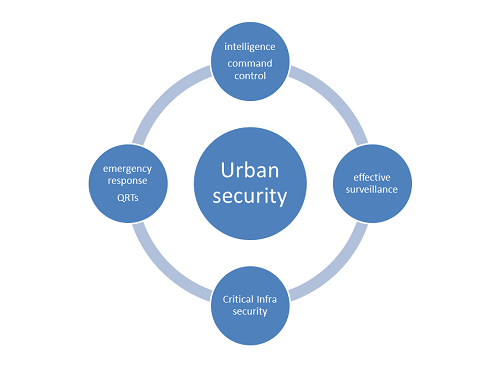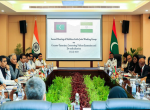Mumbai in July 2011.
Three bomb blasts in a matter of half an hour shook Mumbai again, killing 21 people.
A sense of déjà vu prevailed. But there was a vital difference between earlier attacks on Mumbai and the July 2011 bombings.
This time telephone and mobile lines, overloaded with panicky calls, froze.
So much so that key decision-makers in the Mumbai metropolitan area, from the Chief Minister downwards, could not communicate with each other for over 15 minutes in the immediate aftermath of the blasts.
This incident brought home, starkly, the shortcomings in India’s policing infrastructure: Communication equipment remains outdated; mobility is severely hampered; preventive and pre-emptive measures against a terrorist attack are virtually non-existent.
That there are massive challenges to India’s internal security—aided by external factors—is now a well-known fact. What is not common knowledge however is that the Ministry of Home Affairs (MHA) has been making deliberate and concerted efforts to plug the very obvious gaps in the security architecture of the country.
However given the size, diversity and myriad nature of threats that exist in India, the MHA and various organisations under it have a mammoth task ahead to secure the country.
While India has had reasonable success in confronting the secessionist, ethnic movements in the North-east and in Kashmir, the externally-sponsored jihadi threat in India’s biggest cities is emerging as the greatest challenge for the security managers.
The jihadi elements are a more potent threat for two reasons: One, they have linkages across continents and certainly across Asia, are technology-savvy, are well-funded and their target is India’s big metropolises.
The repatriation from Saudi Arabia of Zakiuddin Anasari alias Abu Jundal, one of the masterminds of the 26/11 Mumbai attacks and his subsequent revelations have brought home this fact more starkly than ever before.
Till two decades ago, the biggest threat in Indian cities was limited to ethnic or communal flare ups. Riots of the kind that happened in Ahmedabad, Meerut, Kolkata, Bhiwandi between Hindus and Muslims and in Delhi between Sikhs and Hindus were the main law and order challenges faced by Indian policemen.
Turning Point
But the serial bomb blasts in Mumbai in March 1993 and the subsequent riots thereafter completed transformed the security landscape in India. Terror had arrived big time in India. The modus operandi adopted by the new perpetrators of violence was something that was unknown to the Indian security apparatus. RDX was used for the first time.
The well-entrenched local mafia network actively supported, funded and armed by an external agency inimical to India introduced a paradigm shift in terror tactic that has been bleeding India time and again for the past two decades.
The delivery boys of violence are no longer identifiable easily. They operate in the shadows; have a pan-India presence and sanctuaries across Asia. Their funding comes from Pakistan, their foot soldiers can be from any state in India.
Their favourite weapon is the IED: the improvised explosive device. Unobtrusive but deadly.
Jaipur, Surat, Bangalore, Ahmedabad, Pune, Mumbai, Delhi…the list reads like a who’s who of Indian cities. The figures are staggering. According to the South Asian Terrorism Portal (satp.org) between 1994 and May 2012, over 61,000 people including civilians, security personnel and terrorists, have died in violence in India.
That’s on an average 5,000 people dying violently in a year!
For example n estimate by Asian Economy Institute in the immediate aftermath of the Mumbai attack of November 2008 said, the Indian Economy took a hit of over 100 billion dollars during the three days that the Lashkar-e-toiba terrorists held the city and indeed India to ransom.
Terrorism is therefore clear and present danger for an India that is economically growing faster than most of the world and is poised to become a regional power in the next decade.
Thus the Government’s first priority is to evolve a meaningful, effective counter-terrorism strategy.
At the centre of this strategy is the security of 10 big cities.
So what constitutes protection of cities and mega cities? So what are the vulnerabilities in big cities? And how do governments hope to tackle them?
Ever since the 9/11 incident forced a paradigm shift in the concept of securing urban areas, security mandarins have grappled with conflicting ideas to evolve a workable counter-terrorism model.
In 2006-07, MHA designated seven urban areas-- Mumbai, Kolkata, Delhi, Chennai, Hyderabad and Bangalore and Ahmedabad—as mega cities in need of a special security grid.
Thus Mega City Policing is built around four major components.

A correct mix of tech Int (technology-based intelligence) and HumInt (Human Intelligence) is required to prevent terrorist attacks anywhere. Indian agencies have so far been pre-dominantly dependent on human intelligence but slowly, technical intelligence is being given equal if not more importance. In order to evolve a comprehensive security plan.
Under the MHA’s Mega City Policing scheme coupled with city-specific plans, new technically gadgets and schemes are being included in the plans.
Financial assistance is given to mega cities for procurement of modern and innovative equipment like Night Vision Devices, GPS/GIS for dial 100 system and patrol cars, surveillance camera systems, CCTV systems, security equipments like portable x-ray machines, vehicle scanner, vehicle number plate identification system, cyber patrol and communication monitoring system, integrated GIS based automated vehicle tracking and management system, etc.
The Mega Cities are asked to prepare individual, city specific plans for consideration of the Government every year. The Plan should be based on a study on specific problem areas of Mega City Policing including details of demographic growth pattern, special problems faced in policing in large urban areas and crime investigation, traffic management, infrastructure available in terms of modern control rooms, digital radio trunking, communication system, PCR van network etc.
Therefore, the crucial equipment that the government is looking for is in two areas: Pre-event and post event.
MHA has recognised that seamless integration of the different components of a security system is essential to obtain maximum efficiency and effectiveness. The integration also needs to extend to backend applications such as e-governance systems and other online and IT systems.
As Home Minister P. Chaidambaram said in 2009: "The police stations in the country are, today, virtually unconnected islands. Thanks to telephones and wireless, and especially thanks to mobile telephones, there is voice connectivity between the police station and senior police officers, but that is about all. There is no system of data storage, data sharing and accessing data. There is no system under which one police station can talk to another directly. There is no record of crimes or criminals that can be accessed by a Station House Officer, except the manual records relating to that police station.”
The Home Ministry has, since 2009 consistently increased the budget for internal security and specifically for modernisation of police forces. However tardy and sometimes indifferent implementation by state governments has created gaps in India’s preparedness for internal security.
In April 2012, P. Chidambaram told a Chief Ministers conference: “Modernisation of Police Force (MPF) scheme was allotted Rs.1,111 crore in 2011-12, but we had to surrender Rs. 311 crore because some States had large unspent balances. For the current year, we have been able to secure Rs.900 crore and I would urge State Governments to address the deficiencies in the implementation of the scheme to help me request the Finance Minister for more funds.”
In fact funds are not a problem. An effective roadmap for strengthening internal security is.
Some elements are in place. For example, the Multi Agency Centre (MAC) and the Subsidiary MACs at the State capitals. NATGRID is work in progress. CCTNS (Crime & Criminal Tracking Network and Systems), under implementation since 2010, has reached the crucial milestone of selection of System Integrator, but only 16 out of 35 States/UTs have completed the task. On the other hand, the development of Core Application Software (CAS) has been completed, field testing is under way, and agreements have been signed to establish nation-wide connectivity.
The Cabinet Committee on Security (CCS), India’s highest decision-making body for security-related matters had approved an Rs 8,500 crore plan to revamp the country’s maritime security architecture.
It had identified that for effective coastal security, India requires maritime patrol boats, ferries, fast attack vessels, maritime surveillance systems and equipment, access control systems, biometric systems, CCTV equipment, thermal imaging system, explosives detection equipment, radar systems, screening technologies, cameras x-ray body scanners and baggage scanners, early warning systems, identification systems, transponders, etc.
The Indian Coast Guard itself is looking to procure 5 offshore patrol vessel, 10 fast-attack craft, 20 interceptor boats, hovercrafts, radars, 12 Dornier aircraft and 30 helicopters, among other things.
In short, India’s homeland security agencies, which primarily consist of the paramilitary forces, state and central police forces and the intelligence agencies, are likely to spend over $ 7.5 billion and state governments close to $ 2 billion on the modernization of their police and para-military organizations in the next 3-5 years. A huge market exists but unless a proper roadmap and strict deadlines to implement the plans evolve, no amount of good intention is likely to make India secure.
Published Date: 4th July 2012









Post new comment